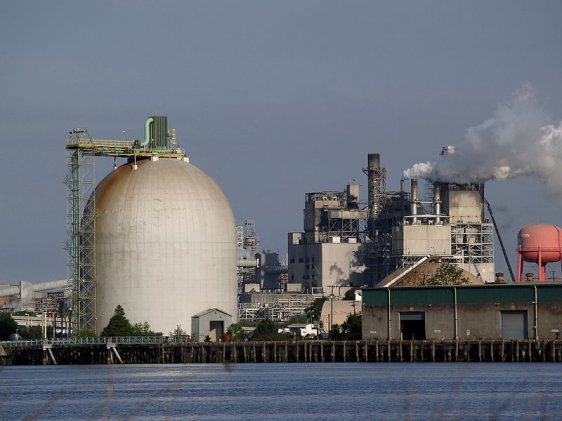 Georgetown, the county seat of Georgetown County, is the second largest seaport and third largest city in South Carolina. It covers 7.2 sq mi (18.6 sq km) and has a population of 9,000 people (2011 estimate).
Georgetown, the county seat of Georgetown County, is the second largest seaport and third largest city in South Carolina. It covers 7.2 sq mi (18.6 sq km) and has a population of 9,000 people (2011 estimate). Industrial plants in Georgetown, South Carolina
Industrial plants in Georgetown, South CarolinaSource: https://commons.wikimedia.org/wiki/File:Georgetown_SC_silo.jpg
Author: Mpbaugh

Georgetown faces Winyah Bay, which opens to the Atlantic Ocean. The Great Pee Dee River, the Waccamaw River and the Sampit River all empty into the bay, which was created either by the submerging coastline or a rise in the ocean level.
Georgetown occupies a unique position in American history, for it was here that the first European settlement in North America was established, by the Spanish under Lucas Vásquez de Ayllón, in 1526. This initial pioneer station did not last long, as a variety of obstacles (among them fever epidemic, slave revolt, Indian attacks) all forced the settlers to pull out.
Over a century later, the English arrived in the area and began trading with the local Indians. This laid the groundwork for the founding of the city of Georgetown by Elisha Screven in 1729. The original city, designed in grid, survives till this day, and is listed as a National Register of Historic Places.
In the early days, Georgetown depended on the growing of indigo as its main cash crop. After the American Revolutionary War, rice surpassed indigo in importance. Slave laborers were used to build gams, locks and canals to irrigate rice fields in the area. Prosperity generated by rice growing in Georgetown also benefited nearby Charleston, which developed a merchantile economy.
The American Civil War shattered the regional economy, and Georgetown was not spared. The hardship continued in the Reconstruction years (1865-76), compounded by crop failure, bad weather and shortage of labor. The city shifted away from rice growing and into the processing of wood products.
The 20th century brought renewed prosperity under the able leadership of Mayor William Doyle Morgan, who introduced electricity, telephone, sewer facilities, rail connection and improved public infrastructure to Georgetown. Then came the Great Depression, which brought another round of hardship.
As with many of the cities along the South Carolina coast, Georgetown was badly hit by Hurricane Huge in 1989. It was quite badly devastated. Since then, the city has been rebuilt. In recent years, it began to tap its historic district for its heritage tourism potential.
Visiting Georgetown
Going to Georgetown involves taking some of the smaller country roads. Leave Interstate 95 at Exit 119 to Manning. Continue east on US Highway 521 through Greeleyville, Andrews and eventually arrive in Georgetown.Places of Interest in Georgetown
- Georgetown County Museum
Museum documenting the three-hundred-year history of the city, with displays of Native American artifacts and other items from the early days. - Kaminski House
Named after former mayor Harold Kaminski, the building built in the 1700s provides a glimpse into the home of three former mayors. - Rice Museum
Museum housed in the city clock tower building. It provides the history of rice cultivation in Georgetown.
 Latest updates on Penang Travel Tips
Latest updates on Penang Travel Tips
About this website

Dear visitor, thank you so much for reading this page. My name is Timothy Tye and my hobby is to find out about places, write about them and share the information with you on this website. I have been writing this site since 5 January 2003. Originally (from 2003 until 2009, the site was called AsiaExplorers. I changed the name to Penang Travel Tips in 2009, even though I describe more than just Penang but everywhere I go (I often need to tell people that "Penang Travel Tips" is not just information about Penang, but information written in Penang), especially places in Malaysia and Singapore, and in all the years since 2003, I have described over 20,000 places.
While I try my best to provide you information as accurate as I can get it to be, I do apologize for any errors and for outdated information which I am unaware. Nevertheless, I hope that what I have described here will be useful to you.
To get to know me better, do follow me on Facebook!
Copyright © 2003-2025 Timothy Tye. All Rights Reserved.

 Go Back
Go Back